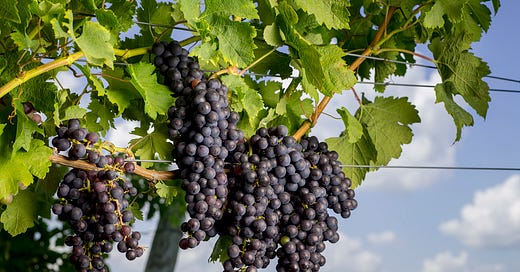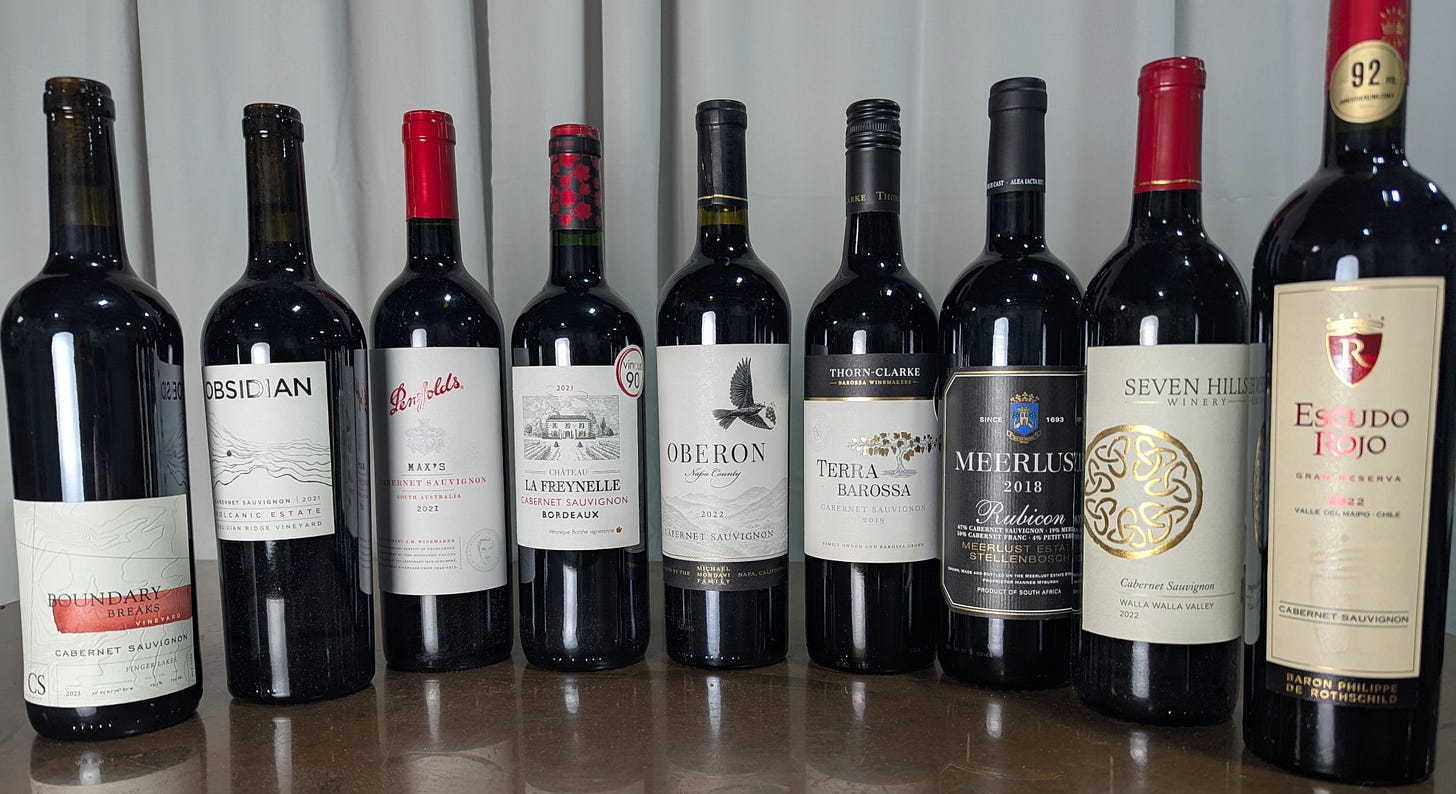#119 Would You Buy an Authentic, Cabernet Sauvignon with a 87-Pt Rating?
If the price is less than $25, does that make a difference? Does Cab Sauv have to be a "cult grape," or can it be "just another grape?"
Our Cabernet Sauvignon grapes, planted in 2013, hanging in our vineyard with Seneca Lake in the background. On Jan. 25-26 our next Winter Wine Exploration session will explore ten Cabernet Sauvignon wines from around the world, including some from the Finger Lakes. These wines mostly sell for less than $25 per bottle. We will be asking the question, “Does Cabernet Sauvignon have to be a “cult wine?” Or can it just be another red wine?
Cabernet Sauvignon is the world’s most popular red wine. Even though there are more than 100 acres of Cab Sauv planted in the Finger Lakes, it has never been considered an acceptable grape to make into a varietal wine in our region.
But, in light of overall global warming trends, is it worth re-considering this?
Cab Sauv is a late-ripening variety, and in the short growing season that we have in the Finger Lakes, it is difficult to get it ripe. Under-ripe Cab Sauv tastes “green” and overly-tannic.
More importantly, it doesn’t taste like Cab Sauv from California. The wine consumer, conditioned by the dominant style of the California Cab Sauv, has never been that interested in the Cab Sauv produced here.
We planted Cab Sauv in 2013 after we experienced a very warm, dry growing season in 2012. We planted small amounts of the three Bordeaux red varieties—Cab Sauv, Merlot and Cab Franc. In 2023, we also acquired nearly three acres of Cab Sauv when we purchased 73 acres on a piece of land adjacent to ours.
So we have enough Cabernet Sauvignon now that we can’t ignore it. We have to decide what to do with it, and that leads us to the topic of this coming weekend’s Winter Wine Exploration.
Pictured above are the Cabernet Sauvignon wines we will be pouring at next weekend’s Winter Wine Exploration. None are “cult” wines. They are meant to be reasonably-priced, and approachable. The critics, however, don’t rate them very highly. Because they are not up the standards of cult Cabernets, they don’t get much respect. Unfair?
We will be tasting ten different Cab Sauvs from around the world. The Winter Wine Exploration series are sessions we hold during the off-season that explore topics that we feel can help us improve our own wines. We invite guests to share in the experience. Reservations are available here.
None of these wines we will be pouring next weekend would be considered “cult Cabs.” With the exception of one or two wines, they are all priced under $25 and they are relatively young. We tried to get as many as we could from cooler climates—which is a difficult thing to do. What we are looking for are wines comparable to those we believe can be made here, provided we employ careful vineyard management techniques. Among these are removing leaves around the clusters and reducing the overall crop load so that the clusters that remain on the vine have the best chance of becoming ripe.
We also aimed for wines that are not “manufactured, manipulated, or mass-produced wines.” Although a Cabernet Sauvignon “box-wine” is very drinkable and affordable, we are looking for what we consider “authentic” wines. To the extent that we can tell, these are wines that are made in smaller volumes and are not constructed to appeal to a mass audience. They are what they are, for better or worse.
We hold three separate sessions on the weekend; two on Saturday at 11 AM and 2 PM; and one on Sunday at 12 Noon. We spend an hour-and-a-half tasting and discussing the wines. Then, at the end, we pour two wines blind and ask our guests to tell us what they think is in their glasses.
The point of all this is to take a moment to assess this varietal in a new context. Provided that it is priced reasonably, can a wine that is good, but not at the level of the finest in the category, have a future?







While my only experiences with Cab Sauv is California wines and one from Central Pennsylvania (we prefer the Cab Franc) I have expanded my tast to Pino Noir and just recently a Malbec from and Argentina I find in Pittsburgh. While we cannot make it to this grand experiment, I look forward to your final results. I know that you, Diane and the rest of the team will make this grape into an enjoyable experience. You have also given me an idea to try this tasting experience in my own home with a gathering of friends and family. That is the true giving of wine, you can find something everyone's palette can enjoy while enjoying each other's company. Boundary Breaks has never disappointed us.
As I grew older I found the high-alcohol, big, bold, tannic, monsters that California Cabs are was no longer for me. Yes, my taste buds changed with age but I also had discovered how fruit and acid can be so very tasty and interesting.
If we could produce Cab Sauv that has more of the character of, say, Syrah than Cali Cabs that would be my dream. Something that highlights the fruit. But that is how my tastes run. Seeing what other cooler regions are doing with Cab will be fun. I cant wait to try them!